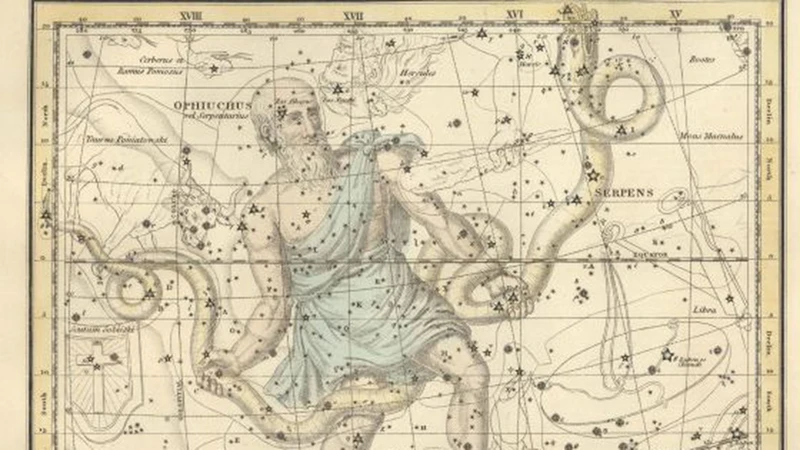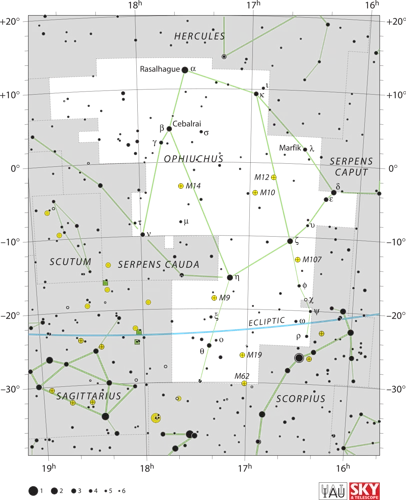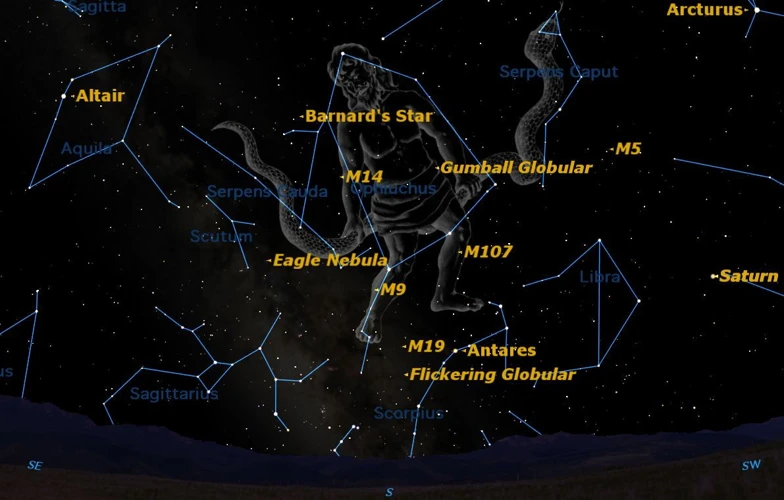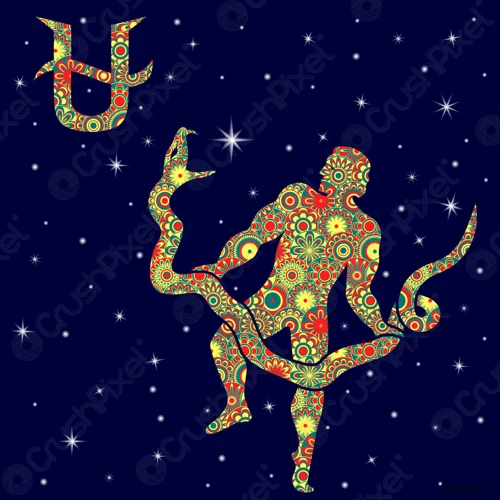In a realm shrouded in mystery and enchantment, the ancient Mesopotamian Zodiac offers a captivating journey into the past. By exploring the celestial wonders that encompass the constellation of Pisces, we unravel the threads of an ancient tapestry woven by the stars. From the origins of the Mesopotamian Zodiac to the role of astrology in their culture, the significance of Pisces in this celestial realm takes on a profound meaning. Join us as we delve into the rich history, symbols, and interpretations that bring this ancient wisdom to life. Embark on a quest to discover the mesmerizing beauty and timeless tales of the Mesopotamian Zodiac and the constellation of Pisces.
Contents
- The Mesopotamian Zodiac
- The Constellation of Pisces
- Ancient Mesopotamian Astrology
- The Significance of Pisces
- Conclusion
-
Frequently Asked Questions
- 1. What is the significance of the Mesopotamian Zodiac in ancient Mesopotamian culture?
- 2. How did the ancient Mesopotamians interpret the symbols of the Mesopotamian Zodiac?
- 3. What celestial objects were the ancient Mesopotamians particularly interested in?
- 4. How did the Mesopotamian Zodiac differ from the Western Zodiac?
- 5. What role did astrology play in ancient Mesopotamian society?
- 6. Was the Mesopotamian Zodiac solely used for astrology, or did it have other purposes?
- 7. What stories and myths are associated with the constellation of Pisces in Mesopotamian culture?
- 8. Did the ancient Mesopotamians believe that the zodiac signs influenced an individual’s personality traits?
- 9. How did the Mesopotamians use the Mesopotamian Zodiac in their medical practices?
- 10. What is the modern-day significance of the Mesopotamian Zodiac?
- References
-
Frequently Asked Questions
- 1. How did the concept of zodiac signs originate in ancient Mesopotamia?
- 2. What is the historical significance of the Mesopotamian zodiac?
- 3. What symbols and representations are associated with the Mesopotamian zodiac?
- 4. What is the astronomical background of the constellation of Pisces?
- 5. What mythological connections are tied to the constellation of Pisces?
- 6. What role did the zodiac play in Mesopotamian astrology?
- 7. How was Pisces interpreted in Mesopotamian astrology?
- 8. What is the significance of Pisces in astrology today?
- 9. What other astrological systems were influenced by the Mesopotamian zodiac?
- 10. How does the ancient Mesopotamian zodiac continue to impact astrology today?
- References
- Read More
The Mesopotamian Zodiac

The Mesopotamian Zodiac, an ancient astronomical system that originated in Mesopotamia, holds a profound significance in understanding the cosmos through the lens of ancient civilizations. This celestial framework consisted of twelve divine symbols, each representing a specific month of the year. Origins of the Mesopotamian Zodiac can be traced back to the earliest civilizations in Mesopotamia, where the celestial observations and interpretations played a crucial role in religious and societal rituals. History and Significance of the Mesopotamian Zodiac reveal its enduring influence on subsequent astrological systems. The zodiac signs were associated with deities, providing a means for the ancient Mesopotamians to connect with the divine forces of the universe. Symbols and Representations of the Mesopotamian Zodiac were a unique blend of celestial and earthly elements, showcasing the intricate relationship between cosmic patterns and human existence. These captivating symbols elucidate the rich cultural tapestry woven by the Mesopotamians, brimming with mythological anecdotes and divine tales. (Internal link: Pluto’s Power of Transformation and Evolution)
1. Origins of the Mesopotamian Zodiac
The origins of the Mesopotamian Zodiac can be traced back to the ancient civilizations of Mesopotamia, known as the cradle of civilization. This profound celestial system emerged as early as the 2nd millennium BCE, and it played a pivotal role in shaping the worldview and religious practices of the Mesopotamians. The Mesopotamian zodiac drew inspiration from the movements of celestial bodies, particularly the sun, moon, and visible planets. The ancient Mesopotamians observed the patterns of these celestial entities and recognized their influence on earthly events and human lives. The development of the zodiac in Mesopotamia stemmed from the desire to understand and interpret these cosmic phenomena, leading to the creation of a celestial framework consisting of twelve distinct symbols or signs that corresponded to specific months of the year. The Mesopotamians believed that these signs represented divine beings, linking the celestial realm with earthly existence. Additionally, the Mesopotamian zodiac was intertwined with the agricultural calendar, allowing the people to track the seasonal cycles and plan their agricultural activities accordingly. The knowledge and practices surrounding the Mesopotamian Zodiac were passed down through generations, influencing the development of astrology in subsequent cultures and civilizations. The intricate and intertwined relationship between the celestial and earthly realms showcased the deep reverence and curiosity the ancient Mesopotamians held for the cosmos. (Internal link: Mythical Beings in the Mayan Underworld)
2. History and Significance
The history and significance of the Mesopotamian Zodiac are deeply intertwined, offering profound insights into ancient civilizations and their understanding of the heavens. Delving into this rich tapestry of cosmic knowledge, we uncover the mesmerizing tale of the zodiac’s origins and the enduring impact it had on ancient Mesopotamian culture.
1. **Early Beginnings:** The history of the Mesopotamian Zodiac traces back to the earliest civilizations in Mesopotamia, such as the Sumerians and Babylonians. These civilizations closely observed the heavens, believing that celestial events held great significance for earthly affairs.
2. **Accumulation of Knowledge:** Over time, ancient Mesopotamians meticulously documented their observations of the stars and planets, meticulously recording and predicting celestial events. These records formed the foundation of astrological knowledge, which would later evolve into the intricate system of the Mesopotamian Zodiac.
3. **Divine Associations:** The Mesopotamians attributed divine qualities and significance to the zodiac signs, intertwining their religious beliefs with celestial interpretations. For them, the gods and goddesses governed not just specific aspects of daily life but also celestial bodies, and the movement of these bodies influenced human destinies.
4. **Astrological Influence:** The Mesopotamian Zodiac’s significance extended beyond a mere means of tracking time. It held a profound influence over various aspects of Mesopotamian society, including religion, agriculture, and political decisions. Astrologers and priests interpreted celestial events, using the zodiac as a guide to divine the wishes of the gods.
5. **Enduring Legacy:** The knowledge and traditions surrounding the Mesopotamian Zodiac were passed down through generations, leaving an indelible mark on subsequent cultures and astrological systems. The influence of Mesopotamian astrology can still be seen in modern Western astrology today.
The history and significance of the Mesopotamian Zodiac serve as a testament to the human fascination with the cosmos and our quest to unravel its mysteries. Exploring this ancient wisdom allows us to peak into the rich cultural heritage of the Mesopotamians and gain a deeper appreciation for our ancestors’ connection with the celestial realm. (Internal link: Types of Eclipses Explained)
3. Symbols and Representations
Symbols and representations within the Mesopotamian Zodiac reflect the ancient Mesopotamians’ deep understanding and observation of the celestial realm. Each zodiac sign was depicted using a combination of animal, human, and divine elements, imbuing them with unique qualities and symbolism. Let’s explore some of these fascinating symbols and representations:
1. Ram: The first sign of the Mesopotamian Zodiac, known as the Ram, combines the strength and dominance of a ram with the wisdom and authority of a human figure. This symbolizes power, leadership, and spiritual guidance.
2. Bull: Representing fertility, courage, and prosperity, the Bull symbol often featured a combination of human and bull elements. It embodies the Mesopotamians’ reverence for nature and their understanding of the vital role of agriculture in their society.
3. Twins: The Twins symbolize duality and harmony. Sometimes depicted as two human figures holding hands or staring into each other’s eyes, it is believed to represent the balance between opposites — day and night, light and dark, and male and female.
4. Crab: The Crab symbolizes adaptability and protection. With its tough outer shell and a swift ability to navigate between land and water, it represents the Mesopotamians’ understanding of the ever-changing tides of life.
5. Lion: The Lion symbolizes kingship, strength, and bravery. Often depicted as a regal creature with a human head, it represents not only the power of the lion but also the wisdom and authority of human rulers.
6. Scales: Representing justice, balance, and the weighing of one’s actions, the Scales symbol reflects the Mesopotamians’ belief in cosmic order and moral responsibility.
7. Scorpion: Symbolizing transformation and protection, the Scorpion represents the power to heal and harm. It serves as a reminder of the Mesopotamians’ understanding of life’s cycles and the need to navigate the challenges of transformation.
These symbols and representations within the Mesopotamian Zodiac offer a glimpse into the ancient Mesopotamians’ perception of the cosmos and their place within it. Each sign carried its own unique meaning and significance, playing a vital role in shaping their beliefs, rituals, and understanding of the world around them.
The Constellation of Pisces

Situated within the celestial realms, the constellation of Pisces holds a mesmerizing allure that has captivated ancient civilizations throughout history. Astronomical Background sheds light on the position of Pisces in the night sky, forming part of the Zodiacal band that encompasses the sun’s annual path. This constellation, comprised of faint stars, lies in the southern celestial hemisphere and is easily recognizable by its distinct shape resembling two fish swimming in opposite directions. Legends and folklore have attributed various mythological connections to Pisces, adding to its mystical appeal. Mythological Connections entwine Pisces with the stories of Aphrodite and her son Eros, who transformed into fish to escape the monster Typhon. The constellation also intersects with other mythological tales, creating a celestial tapestry that weaves together the rich cultural fabric of ancient civilizations. Observing the constellation of Pisces invites us to ponder the eternal dance between myth and the stars, unlocking the wonders of the universe.
1. Astronomical Background
The Astronomical Background of the constellation of Pisces provides a fascinating glimpse into the celestial wonders of the night sky. In this section, we will delve into the key aspects that make up this intriguing astronomical background. Pisces Location: Pisces is located in the northern celestial hemisphere, between Aries and Aquarius. It spans approximately 30 degrees of the zodiac. Visibility: Pisces is visible from both the northern and southern hemispheres during different times of the year, particularly during the late autumn and early spring months. Stars: The constellation of Pisces is home to a cluster of stars, with its most notable ones being Alpha Piscium and Epsilon Piscium. These stars, along with others, form the distinctive pattern that represents the fish in the sky. Other Celestial Objects: Within the borders of Pisces, several galaxies, including the unique ring galaxy Hoag’s Object, can be observed. There are also notable planetary nebulae and globular clusters within the vicinity of Pisces. This astronomical background of Pisces sets the stage for further exploration of the mythological and astrological significance this constellation holds.
2. Mythological Connections
Mythological Connections associated with the constellation of Pisces in the Mesopotamian Zodiac add a layer of enchantment to its celestial significance. In Mesopotamian mythology, the fish symbol in Pisces is often linked to the goddess Atargatis, who was believed to have emerged from the sacred waters. This goddess is associated with fertility, abundance, and protection. The mythological connection between Atargatis and the fish is prevalent in various ancient cultures, including the Phoenicians and Assyrians, who revered Atargatis as a powerful and benevolent deity. According to mythological tales, Atargatis transformed herself into a fish out of grief and love for a mortal shepherd, resulting in the creation of the constellation of Pisces. The fish symbolism in Pisces also has ties to the ancient Babylonian god, Oannes, who was depicted as a fish-human hybrid. Oannes was known to have brought wisdom and knowledge to humanity, appearing from the depths of the Persian Gulf during the day to teach and impart his wisdom before returning to the waters at night. These mythological connections serve as a captivating reminder of the intricate relationship between the celestial realm and the stories woven by ancient civilizations.
Ancient Mesopotamian Astrology

Ancient Mesopotamian Astrology is an intricate system that intertwined the celestial world with human affairs, providing insights and guidance in various aspects of life. The role of the Zodiac in Mesopotamian Astrology was central, as it served as a blueprint for interpreting celestial phenomena and their impact on earthly matters. Through meticulous observations and astrological charts, ancient Mesopotamians sought to understand the cosmic influences on individuals, cities, and even kingdoms. Interpretation of Pisces in Mesopotamian Astrology held a special place, representing a constellation associated with water and the divinities linked to it. This watery connection symbolized the flow of birth, renewal, and abundance, shaping the interpretation of individuals born under the Pisces sign as compassionate, intuitive, and artistic souls. The ancient Mesopotamian understanding of astrology paved the way for future astrological systems, leaving an indelible mark on human exploration and interpretation of the celestial realm.
1. Role of Zodiac in Mesopotamian Astrology
The role of the Zodiac in Mesopotamian Astrology was paramount in their understanding of celestial influences on human lives. The Mesopotamians believed that the celestial bodies, including the planets and constellations, held immense power and influence over the affairs of both individuals and societies as a whole. The Zodiac, with its twelve divine symbols, served as a blueprint for interpreting these celestial energies. These symbols, known as “signs,” were associated with specific deities and their corresponding attributes. The position of the planets and the interactions between different signs were carefully observed and analyzed to determine a person’s fate, character traits, and even the most auspicious times for various activities. The Mesopotamians believed that by aligning themselves with the celestial forces represented by the Zodiac signs, they could navigate the complexities of life more effectively and seek divine guidance. The Zodiac, therefore, formed the foundation of Mesopotamian Astrology, guiding their beliefs and practices in interpreting celestial phenomena and their impact on human destinies.
2. Interpretation of Pisces in Mesopotamian Astrology
In the realm of Mesopotamian Astrology, the interpretation of Pisces held a significant place, offering insights into the cosmic forces that influenced the lives of ancient civilizations. This celestial constellation, depicted as two fish swimming in opposite directions, carried profound symbolic and astrological meaning. The Interpretation of Pisces in Mesopotamian Astrology highlighted themes of duality, fluidity, and the interplay between the earthly and divine realms. The fish, representing the Babylonian god Ea and his consort Damkina, embodied the balance and harmony between the forces of creation and destruction. Mesopotamian astrologers believed that those born under the sign of Pisces possessed a deep connection to the spiritual world and possessed an intuitive understanding of the mysteries of life. They were considered individuals with heightened sensitivity, creativity, and a propensity for empathetic relationships. The presence of Pisces in a person’s astrological chart was believed to signify periods of transition, spiritual growth, and the need for emotional healing. The influence of Pisces in Mesopotamian Astrology was not limited to individual horoscopes but also extended to agricultural predictions, navigational guidance, and societal events. These interpretations of Pisces allowed the ancient Mesopotamians to align their lives with the movements of the celestial bodies and seek guidance from the mesmerizing tapestry of the stars.
The Significance of Pisces

The Significance of Pisces in the realm of ancient Mesopotamian astrology holds a deep and symbolic meaning. Pisces, the twelfth sign of the zodiac, is represented by two fish swimming in opposite directions, connected by a cord. This duality embodies the fluid and mutable nature of Pisces individuals, known for their adaptability and empathy. In Mesopotamian astrology, Pisces was associated with the god Ea, the deity of wisdom, knowledge, and the primordial ocean. This connection reflects the watery characteristics of Pisces, as well as their intuitive and compassionate nature.
Pisces is considered a receptive and empathetic sign, often associated with the realm of dreams, imagination, and the subconscious. It is believed that those born under the sign of Pisces possess heightened intuitive abilities and are deeply attuned to the emotions of others. They are known for their compassionate nature and desire to help those in need. This empathy and sensitivity are thought to be influenced by the connection between Pisces and the Mesopotamian god Ea, representing the depth and vastness of the primordial ocean.
In ancient Mesopotamian astrology, the celestial phenomenon of the constellation of Pisces played an essential role in predicting and interpreting the events and fate of individuals. It was believed that the position of the stars and planets during a person’s birth would influence their future and personality traits. Pisces, being the last sign of the zodiac, represented the culmination of the astrological cycle, symbolizing the end of one phase and the beginning of another.
In Mesopotamian culture, the sign of Pisces was also associated with the harvest season, signaling a time of abundance and fertility. The fish symbolism was linked to the importance of water in sustaining life, particularly in an agrarian society reliant on successful harvests. This connection reinforced the idea of Pisces as a sign of abundance, growth, and the cycle of life.
The significance of Pisces in ancient Mesopotamian astrology encompassed the themes of duality, empathy, intuition, and the cyclical nature of life. It was a symbol of adaptability and compassion, guided by the deity Ea and associated with the depths of the primordial ocean. Pisces represented the culmination of the zodiac cycle and held a vital place in predicting and interpreting a person’s destiny. As we journey into the past, unraveling the mysteries of the Mesopotamian Zodiac, the sign of Pisces emerges as a celestial beacon, connecting the realms of the earthly and the divine.
Conclusion

The culmination of our exploration into the ancient Mesopotamian Zodiac and the constellation of Pisces leads us to a profound understanding of the cosmic tapestry woven by our ancestors. As we journeyed through the origins, history, symbols, and interpretations of this celestial knowledge, we have witnessed the intricate connection between the heavens and human existence. The Mesopotamian Zodiac, with its twelve divine symbols representing each month, serves as a testament to the profound significance of astrology in the ancient Mesopotamian culture. Through their observations of the celestial bodies and their interpretations, the Mesopotamians sought to understand the cosmos and its impact on their daily lives. The constellation of Pisces, with its astronomical background and mythological connections, further adds to the depth and complexity of this ancient wisdom. In Mesopotamian astrology, Pisces held a special place as it symbolized the great cosmic cycle of life and regeneration. Its interpretations were connected to the concept of divine renewal and the cyclical nature of existence. As we conclude this journey into the past, we are reminded of the enduring power of ancient wisdom and the universal human fascination with the mysteries of the cosmos. The Mesopotamian Zodiac and the constellation of Pisces continue to captivate our imaginations, offering glimpses into the profound connections between the celestial realms and the human experience. Through our exploration, we have come one step closer to unraveling the enigmatic web of the stars and embracing the timeless wisdom left behind by our ancestors.
Frequently Asked Questions

1. What is the significance of the Mesopotamian Zodiac in ancient Mesopotamian culture?
The Mesopotamian Zodiac held great significance in ancient Mesopotamian culture as it provided a framework for understanding the cosmos and its connection to human life. It influenced religious and societal practices, serving as a guide for rituals and providing a means to connect with celestial forces.
2. How did the ancient Mesopotamians interpret the symbols of the Mesopotamian Zodiac?
The ancient Mesopotamians interpreted the symbols of the Mesopotamian Zodiac by associating them with specific deities and attributing divine qualities to each symbol. These interpretations were essential in understanding the characteristics and influences associated with each zodiac sign.
3. What celestial objects were the ancient Mesopotamians particularly interested in?
The ancient Mesopotamians were particularly interested in planets and fixed stars. They observed their movements and positions in the sky, believing that they held significant influence over human affairs and events on Earth.
4. How did the Mesopotamian Zodiac differ from the Western Zodiac?
The Mesopotamian Zodiac predates the Western Zodiac and differed in its symbolism and interpretation. While both systems consist of twelve signs, the Mesopotamian Zodiac placed greater emphasis on lunar cycles and the influence of celestial objects on human lives.
5. What role did astrology play in ancient Mesopotamian society?
Astrology played a pivotal role in ancient Mesopotamian society as it was believed to provide insights into the future and guidance in decision-making. Priests and scholars relied on astrology to advise rulers, predict natural events, and interpret the will of the gods.
6. Was the Mesopotamian Zodiac solely used for astrology, or did it have other purposes?
The Mesopotamian Zodiac had multiple purposes beyond astrology. It was also used as a calendar system and for agricultural purposes. The positioning of constellations helped determine the changing seasons, guiding farmers in their planting and harvesting activities.
7. What stories and myths are associated with the constellation of Pisces in Mesopotamian culture?
In Mesopotamian culture, Pisces was associated with the myth of the goddess Atargatis and her lover, the god Ea. The constellation was believed to represent the two merging fish who helped the goddess transform into a mermaid to escape danger.
8. Did the ancient Mesopotamians believe that the zodiac signs influenced an individual’s personality traits?
Yes, the ancient Mesopotamians believed that the zodiac signs influenced an individual’s personality traits. Each zodiac sign was associated with specific attributes and characteristics, shaping one’s behavior, talents, and destiny.
9. How did the Mesopotamians use the Mesopotamian Zodiac in their medical practices?
The Mesopotamians used the Mesopotamian Zodiac in their medical practices, linking different zodiac signs to specific body parts and diseases. This system helped physicians diagnose ailments and prescribe treatments based on the perceived influence of celestial forces.
10. What is the modern-day significance of the Mesopotamian Zodiac?
The Mesopotamian Zodiac continues to intrigue modern scholars and astrologers as a valuable piece of ancient wisdom. It offers insights into the ancient Mesopotamian culture, their observations of the cosmos, and their belief systems. Additionally, it serves as a bridge between the ancient world and modern-day astrology, enriching our understanding of the evolution of celestial interpretation.
References
Frequently Asked Questions

1. How did the concept of zodiac signs originate in ancient Mesopotamia?
The concept of zodiac signs originated in ancient Mesopotamia as a way to track and interpret celestial movements. Mesopotamian astronomers observed the patterns and positions of stars and constellations over time, which led to the development of the zodiac system.
2. What is the historical significance of the Mesopotamian zodiac?
The Mesopotamian zodiac holds great historical significance as it is one of the earliest known astrological systems. It influenced the development of astrology in various cultures and civilizations, including the Greeks and Romans, who later adapted and expanded upon the Mesopotamian zodiac.
3. What symbols and representations are associated with the Mesopotamian zodiac?
The symbols and representations associated with the Mesopotamian zodiac include various animals, mythical creatures, and celestial objects. Each zodiac sign is associated with specific symbols that hold cultural and astrological meaning in Mesopotamian astrology.
4. What is the astronomical background of the constellation of Pisces?
The constellation of Pisces is a prominent feature of the night sky and is composed of various stars. Astronomically, it is located in the southern celestial hemisphere and is part of the zodiac constellation, representing two fish swimming in opposite directions.
5. What mythological connections are tied to the constellation of Pisces?
The constellation of Pisces is associated with different mythological stories and interpretations. In Greek mythology, it is connected to the story of Aphrodite and her son Eros transforming themselves into fish to escape the monster Typhon. The fish later became the constellation of Pisces.
6. What role did the zodiac play in Mesopotamian astrology?
In Mesopotamian astrology, the zodiac played a crucial role as it provided a framework for understanding the influence of celestial bodies on human lives. The position of planets and stars within specific zodiac signs was believed to have a significant impact on individual personalities and events.
7. How was Pisces interpreted in Mesopotamian astrology?
In Mesopotamian astrology, Pisces was associated with the god Ea, who represented wisdom, creation, and the subterranean waters. Individuals born under the sign of Pisces were believed to possess intuitive and artistic qualities, often associated with the flowing nature of water.
8. What is the significance of Pisces in astrology today?
In modern astrology, Pisces is considered a water sign and is associated with empathy, imagination, and spirituality. People born under the sign of Pisces are often seen as compassionate, creative, and in tune with their emotions.
9. What other astrological systems were influenced by the Mesopotamian zodiac?
The Mesopotamian zodiac had a significant influence on various astrological systems throughout history. The Greek and Roman zodiacs, as well as the Western astrological tradition, drew inspiration from the Mesopotamian zodiac and incorporated many of its symbols and interpretations.
10. How does the ancient Mesopotamian zodiac continue to impact astrology today?
The ancient Mesopotamian zodiac continues to impact astrology today by providing a historical and cultural foundation for the study and interpretation of celestial influences. Many astrologers still refer to the Mesopotamian zodiac symbols and meanings as they explore the connections between celestial bodies and human experiences.







